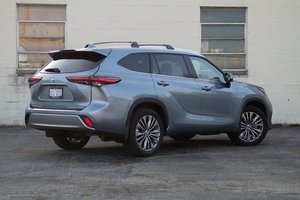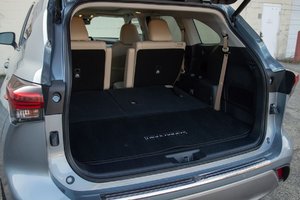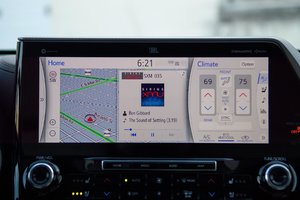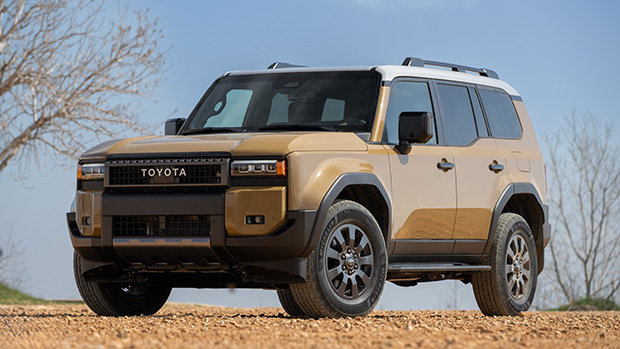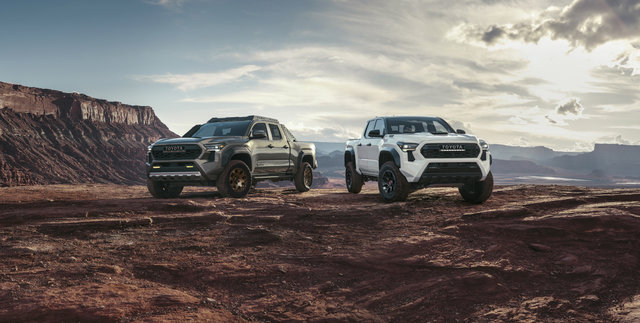The Highlander somehow escaped Toyota's ever-growing desire to make its grilles as large as possible.
It's hard to get excited about a midsize, three-row SUV, unless you have a bunch of kids and even more cargo, at which point this segment will feel like a saving grace. Practicality in this arena long meant foregoing some of the industry's niceties, but the latest crop of crossovers has eschewed that notion. The new-for-2020 Toyota Highlander embodies that idea, tacking some posh silver linings onto an otherwise straightforward family machine to great effect.
The 2020 Toyota Highlander's updates cover just about every corner of the car, from aesthetics to function. Nobody necessarily puts good looks on the front burner in this segment, but the Joneses must be kept up with, and the Highlander adopts a fresh look that genuinely impresses. It looks... cool, actually, with surprisingly strong fenders, en-vogue slim lights and a grille that bucks Toyota's trend of ever-growing maws.
Having taken a few extended road trips in previous-generation Highlanders, I'd have to say that my absolute favorite part of the 2020 model's update is its new interior. It's impressively stylish, especially on my tester's $51,000 Platinum trim (more on that eye-watering sticker later). The dashboard's layering takes on a life of its own, with a strong aluminum-look trim piece moving from the infotainment screen to the passenger-side door frame. Since this is the Highlander's highest trim, there's plenty of stitched leather, leaving only a few hard plastics for areas that are mostly out of sight or require some additional durability, like near the carpet.
The Highlander's new dash design also brings something that every family crossover sorely needs: storage. There's a passenger cubby above the glove box, another one below the infotainment screen (with a second hidey-hole below that one), in addition to your standard door pockets and center console armrest. That latter one is a sticking point for me: The rolling-style opener is surprisingly small, and there's a massive wireless charger you need to rotate upward (?) to access the purse-ish-sized cave inside. Other questionable frippery includes the cord opening between the two centrally mounted cubbies, which is entirely unnecessary since I can just leave my phone in the lower one.
Head a little further back in the 'Yota and you don't lose any inch of near-luxe appointment. The second- and third-row seats are wrapped in the same plush leather as the fronts, and they offer the right mix of comfort and support. It's worth noting, though, that the third row should only be used for toddlers and emergencies; with barely any height delta between the floor and the seat cushion, adults will basically sit in the fetal position for the length of the ride, especially if the second-row occupants don't scooch up. At 6-feet tall, I'd be comfortable back there for five minutes, tops. The third row's best use is in its flattened form, which expands cargo space in a big way.
Just as the interior is a lovely thing with a few barely-there missteps thrown in, the same can be said for the way the 2020 Highlander drives. While previous Highlanders have felt a little flimsy to me, the 2020 model feels solid as a rock. It's nearly Lexus levels of quiet inside, hushing the din of the increasingly messed-up world around us and giving families a little separation time. That isolation is further reinforced through ample suspension travel and, on my Platinum trim, suitably thick Goodyear Eagle Touring all-season tires.
Propulsion for all non-hybrid Highlanders comes from the same engine: a 3.5-liter V6 producing 295 horsepower and 263 pound-feet of torque. I wouldn't call its output sprightly, but it's more than enough to get the whole shebang up to speed on the highway or in traffic, despite the fact that the car has grown between generations whereas output has not. Toyota blissfully skipped over its usual continuously variable transmission in favor of an eight-speed automatic, which is content to knock off shifts in the background with little drama.
The steering is as numb as any other modern Toyota, but it turns the wheels, so I'm not complaining. The brakes and throttle are both dead simple to modulate with smoothness, keeping kids' heads from unnecessarily bobbing about (more than usual, at least, if you let 'em have a soda or two).
While the EPA estimates the all-wheel-drive Highlander Platinum will achieve 20 miles per gallon city and 27 mpg highway, my right foot cannot match those numbers, falling closer to 22 or 23 mpg on the highway and mid-to-late teens in urban driving. I'm really trying, too, I promise. If fuel thrift is high on your must-have list, I would likely point you in the direction of the electrified Highlander Hybrid.
While even some recent Toyotas haven't been the most technologically advanced cars on the block, there's no denying the ever-increasing focus on in-car tech, and the 2020 Highlander is poised to deliver. It all starts with the usual way of interfacing with the telematics: the infotainment screen. An 8-inch display is standard on lower trims, but my Platinum model comes toting a 12-incher that fills the dashboard nicely. Apple CarPlay and Android Auto are both standard across the board, which is fantastic, because they remain my favorite ways to use Toyota's Entune system (read: ignoring it).
Now, there's not anything wrong with the system. In this iteration, it's responsive enough and its size means it's capable of displaying a whole lot of information at once. Yet, the light colorway and slightly awkward jumble of tiles might present a busier appearance than distraction-mitigation efforts would appreciate. It doesn't take long to get used to, though, and I appreciate that the larger screen has a special area dedicated to offering additional information about the climate control, music or fuel economy. Alexa integration is a nice touch for connected families, as is a 4G LTE Wi-Fi hotspot. Fans of traditional buttons will breathe a sigh of relief at the four (admittedly small) switches beneath the screen that offer quick hops to specific parts, whether it's the map or music.
It's a Toyota, so it's almost a given that the 2020 Highlander would pack safety systems out the wazoo. Toyota Safety Sense 2.0, the automaker's suite of active and passive protection tech, is standard on every Highlander. It includes stuff you hope you never need, like lane-departure mitigation and automatic emergency braking with pedestrian detection, in addition to effort-savers like full-speed adaptive cruise control and automatic high beams. Blind-spot monitoring and a surround-view camera are also standard on higher trims, the latter of which is offered in a suitably high resolution for easy curb-rash avoidance.
The third row is best left as an extension of the cargo area, unless you're in a pinch.
The 2020 Highlander may start out a shade under $35,000, but my top-tier Limited AWD tester rings in at a nearly uncomfortable $51,000 and change. Sticking with gas models for better points of comparison, I'd opt for the $40,000-ish XLE FWD trim, which still has loads of safety systems, heated seats and wireless device charging. If you don't mind a smaller screen, leatherette and a non-panoramic moonroof, there's a lot of money to be saved.
The 2020 Toyota Highlander is in the middle of the goddamn Thunderdome. The 2020 Honda Pilot is getting a little old, especially in the infotainment department, but its starting price is lower and it's great to drive. The 2021 VW Atlas was just given a solid visual refresh, and I prefer its interior design to Toyota's. The biggest threats to the Highlander, though, are the 2020 Kia Telluride and 2020 Hyundai Palisade. Frankly speaking, these Korean fraternal twins rock, lifting mass-market transportation almost to the level of art.
But sometimes you just want something that's familiar, and despite being completely redesigned for the 2020 model year, the Highlander is precisely that. Its on-road demeanor is as predictable as the sunset, the correct trims can turn it into 90% of a Lexus and it's loaded with the technological doodads everybody's after in 2020. I'd be doing you lovely readers a disservice by not recommending this get put at or near the top of your three-row-SUV shopping list.



